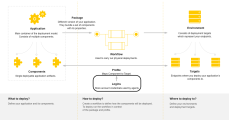Login Objects and Account Credentials
As an Administrator, you use Login Objects to store the account credentials that Agents need for accessing Deployment Targets. The account credentials save login information for either a host (operating system) or a back-end system (for example, Subversion) and they can be related to single Deployment Targets or shared between a set of them (for example, shared account).
Important! The actions that you can perform depend on your folder permissions. See: Assigning Release Automation Permissions.
This page includes the following:
The following graphic illustrates the role of Login objects in the Deployment Model. Select the image to expand it.
Login Objects are stored in separate folders for access rights and permission control. They are linked to Deployment Profiles to allow tasks to be executed under different accounts for each Application and Environment.
The account credentials are a part of the Login object definition. They provide the host and the back-end system names, the user and the password. For example, the host could be the operating system and the back-end system, Subversion.
Viewing Login Objects and Login Credentials
- Open the Release Automation perspective.
- In the Navigator pane, click Settings > Logins. The list of CDA login objects is displayed.
- Select a Login object and click Credentials in the toolbar to display the login credentials in the AWI.
Tip: For more information about how search for entities and narrow down the results, see Advanced Search.
- Click the Create button in the toolbar.
-
All fields on the Create Login dialog are mandatory.
The Name must be unique and can only contain alphanumeric characters, blanks, ".", "-", "_", "@", "$", "#"
- Click Create.
Editing the Properties of a Login Object
Use the Login Object Sidebar that is displayed next to the Logins list to edit the Login object properties:
-
You can edit the Name, Folder and Owner.
-
Limited to 4000 characters.
-
Accessible both from the toolbar or from the context menu. The following actions are available depending on your permissions:
- Delete: see: Deleting Login Objects
- Archive: archives the selected entity. If an entity is archived, Restore is available (see also: Archiving Entities)
Note: You may only delete the entity when you have the appropriate permission on the containing folder (see Security Concept in CDA) and all of the listed conditions are met.
Conditions to delete entities of type LoginObject
- Not referenced by any deployment profiles
- Not referenced by any executions
- Not referenced by any environment snapshots
- Not referenced by any pending adhoc snapshot creation
